Further reading
- Rodriguez P, Munroe D, Prawitt D, et al. (1997). "Functional characterization of human nucleosome assembly protein-2 (NAP1L4) suggests a role as a histone chaperone". Genomics. 44 (3): 253–65. doi:10.1006/geno.1997.4868. PMID 9325046.
- Rodriguez P, Pelletier J, Price GB, Zannis-Hadjopoulos M (2000). "NAP-2: histone chaperone function and phosphorylation state through the cell cycle". J. Mol. Biol. 298 (2): 225–38. doi:10.1006/jmbi.2000.3674. PMID 10764593.
- Shikama N, Chan HM, Krstic-Demonacos M, et al. (2000). "Functional interaction between nucleosome assembly proteins and p300/CREB-binding protein family coactivators". Mol. Cell. Biol. 20 (23): 8933–43. doi:10.1128/MCB.20.23.8933-8943.2000. PMC 86548. PMID 11073993.
- Cicala C, Arthos J, Selig SM, et al. (2002). "HIV envelope induces a cascade of cell signals in non-proliferating target cells that favor virus replication". Proc. Natl. Acad. Sci. U.S.A. 99 (14): 9380–5. doi:10.1073/pnas.142287999. PMC 123149. PMID 12089333.
- Strausberg RL, Feingold EA, Grouse LH, et al. (2003). "Generation and initial analysis of more than 15,000 full-length human and mouse cDNA sequences". Proc. Natl. Acad. Sci. U.S.A. 99 (26): 16899–903. doi:10.1073/pnas.242603899. PMC 139241. PMID 12477932.
- Ota T, Suzuki Y, Nishikawa T, et al. (2004). "Complete sequencing and characterization of 21,243 full-length human cDNAs". Nat. Genet. 36 (1): 40–5. doi:10.1038/ng1285. PMID 14702039.
- Rodriguez P, Ruiz MT, Price GB, Zannis-Hadjopoulos M (2005). "NAP-2 is part of multi-protein complexes in HeLa cells". J. Cell. Biochem. 93 (2): 398–408. doi:10.1002/jcb.20163. PMID 15368365.
- Gerhard DS, Wagner L, Feingold EA, et al. (2004). "The status, quality, and expansion of the NIH full-length cDNA project: the Mammalian Gene Collection (MGC)". Genome Res. 14 (10B): 2121–7. doi:10.1101/gr.2596504. PMC 528928. PMID 15489334.
- Nousiainen M, Silljé HH, Sauer G, et al. (2006). "Phosphoproteome analysis of the human mitotic spindle". Proc. Natl. Acad. Sci. U.S.A. 103 (14): 5391–6. doi:10.1073/pnas.0507066103. PMC 1459365. PMID 16565220.
- Olsen JV, Blagoev B, Gnad F, et al. (2006). "Global, in vivo, and site-specific phosphorylation dynamics in signaling networks". Cell. 127 (3): 635–48. doi:10.1016/j.cell.2006.09.026. PMID 17081983.




